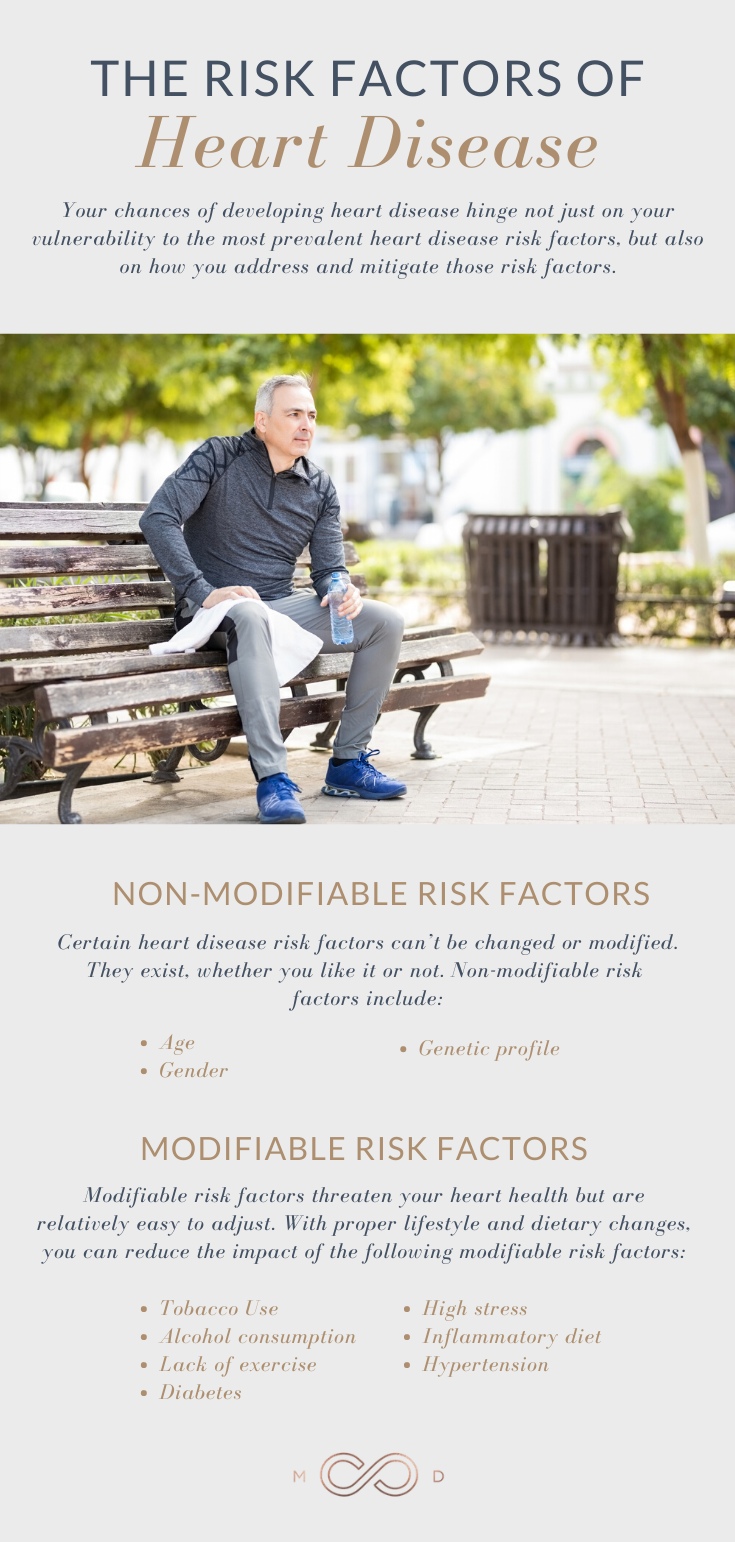Life is risky by nature, but we have the power to make choices that reduce those risks.
You can choose to go skydiving… or not.
You can choose to wear your seatbelt… or not.
And you can choose to get in-tune with your heart and health… or not.
Heart disease isn’t an invisible threat that only happens to 60-year-old men who smoke two packs a day. One in of four deaths is the result of heart disease. That’s one death every 37 seconds.
A dear friend of mine, Dr. Furrukh Malik, has joined me to explore the many layers of heart health and disease. As an invasive cardiologist with specialized training in advanced heart failure and transplantation, Dr. Malik offers valuable insights that may help us understand the real secrets to longevity.
What Does ‘Good Heart Health’ Really Mean?
‘Good heart health’ isn’t a complicated notion. In its simplest form, good heart health means maintaining clean, open blood vessels that support strong, steady circulation.
Think of blood vessels as pipes for all the blood flowing to and from the heart. The pipes must stay open and unobstructed so that blood can quickly deliver oxygen and nutrients to tissues. After which, they transport waste products away.
Good heart health is all too easy to compromise. Just like a bathroom sink becomes clogged with hair, calcium buildup, and toothpaste grime, the pipes of the circulatory system also become blocked from a variety of factors. As those blockages grow, your heart health suffers.
Developing heart disease isn’t like breaking your leg, where your body is healthy one second and debilitated the next. Heart disease brews slowly inside the body, year after year, until symptoms become impossible to ignore.
As Dr. Malik explains, metabolic diseases, inflammatory foods, smoking, and other lifestyle habits all contribute to the development of internal and external inflammation. This double whammy of inflammation attacks blood vessel “pipes” from both directions to lay the foundation for heart disease.
I Have a Family History of Heart Disease: Am I Doomed?
There’s no one linear path to heart disease, even with a strong family history. Your chances of developing heart disease hinge not just on your vulnerability to the most prevalent heart disease risk factors, but also on how you address and mitigate those risk factors.
Dr. Malik organizes heart disease risk factors into two categories: non-modifiable and modifiable.
Non-Modifiable Risk Factors
Certain heart disease risk factors can’t be changed or modified. They exist, whether you like it or not. Non-modifiable risk factors include:
- Age
- Gender
- Genetic profile
These risk factors can’t be switched overnight. Instead, any medical action must carefully take non-modifiable risk factors into consideration.
Modifiable Risk Factors
Modifiable risk factors threaten your heart health but are relatively easy to adjust. With proper lifestyle and dietary changes, you can reduce the impact of the following modifiable risk factors:
- Tobacco Use
- Alcohol consumption
- Lack of exercise
- High stress
- Inflammatory diet
- Developing Diabetes or Hypertension
You can think of heart disease risk factors like layers of an avalanche. Increasing age is always a risk factor, but every additional risk factor makes it more difficult to escape the avalanche of heart disease.
“If you add, say, high blood pressure, the disease progression will increase,” Dr. Malik explains. “If you become diabetic, the disease progression increases further. If you start smoking and consuming a lot of alcohol and fat-rich foods from animal sources, then you’re adding inflammatory components that will speed up the disease further.”
Since your age, gender, and genetic profile are set in stone, it’s up to you to take control of modifiable risk factors and decrease your risk of heart disease as much as possible.
Cardiac Issues Earlier in Life
Historically, we’ve assumed that heart disease only threatens adults who are obese or elderly, but now we’re seeing adults in their thirties and forties developing symptoms of heart disease.
According to Dr. Malik, our methods of food preparation are largely to blame. Our American paradigm of eating has shifted dramatically since the 1950s. Rather than eating small, whole food meals two or three times a day, people, especially children, are often snacking continuously.
“There is a high indulgence of very high carbohydrate-rich foods at a younger age, with a very high proportion of sugar in the food,” Dr. Malik says.
To make matters worse, foods are processed and altered to prolong shelf life, which results in significant metabolic abnormalities.
Dr. Malik expands on the implications of our society’s dietary changes: “My gut feeling is that heart disease is more progressive and apparent earlier because whatever we are putting in our body in the form of high carbohydrate, high processed foods with significant inflammatory components have resulted in an exaggerated expression of disease in a young population.”
Unfortunately, it’s not just adults at risk. I’ve observed a stunning increase in pediatric obesity rates during my time studying obesity. Compared to the number of children diagnosed with obesity 50 years ago, the rate today has more than tripled!
How is such a dramatic, dangerous change possible? It’s a response to the perfect storm of societal changes including:
- Mass agriculture
- Shift to high fructose corn syrup
- Aggressive marketing of highly processed carbohydrates
- Prevalence of fast food
- Focus on video games and social media instead of physical movement
I’ll never forget the words of a cardiologist during my residency who said it won’t be long before pediatricians will need to start screening children for risk factors of heart disease.
The Seven Variables of Heart Disease Risk
Given all of this information, what are the implications of heart disease for you? Consider the seven most influential variable of heart disease risk:
- Age
- Gender
- Smoking History
- Family History
- Blood Sugar
- Blood Pressure
- Cholesterol
These seven variables spell out your risk of heart disease over the next ten years. Though you can’t change your age or gender, you can take active steps to improve your blood sugar, cholesterol, and blood pressure to reduce your risk of heart disease.
If you take the 10-year heart risk test and find that your risk is 7.5% or higher over the next decade, the time to take action is now. Recalculate your risk every one to two years so that you know exactly where you stand, Dr. Malik advises, especially if you have a family history of heart disease.
The Best Diagnostic Tools for Heart Disease
Though the growing rate of heart disease is discouraging, we at least have the benefits of advanced diagnostic tools on our side.
For men and women who are concerned about developing heart disease but haven’t yet experienced serious symptoms, Dr. Malik begins with a risk profile assessment. This type of assessment evaluates cholesterol, hypertension, and diabetes to calculate the risk of heart disease. Dr. Malik uses this information to calculate the patient’s 10-year risk of heart disease or stroke using the Atherosclerotic Cardiovascular Disease (ASCVD) algorithm.
The results of the 10-year risk assessment determine the next best diagnostic steps:
- If a patient’s 10-year risk of heart disease is less than 2%, no further testing is needed. He should adjust modifiable risk factors and manage non-modifiable risk factors to stay as healthy as possible.
- If a patient’s 10-year risk of heart disease falls between 2% and 5%, Dr. Malik recommends non-invasive tests like the calcium cardiac score or carotid ultrasound. These tests for early blockages may indicate further testing is needed.
A calcium cardiac score, which is a low intensity CAT scan of the chest, identifies calcium deposits in the coronary circulation of the heart. Since the coronary arteries supply oxygen-rich blood to the heart, growing blockages pose serious threats to cardiovascular health. The higher a patient’s calcium cardiac score, the higher their risk of a cardiac event:
- Score of Zero: No plaque, low risk of heart attack
- 1-10: A small amount of plaque that equals a less than 10% change of heart disease
- 11-100: Mild heart disease with an increased risk of heart attack and disease
- 101-400: Serious blockages and high risk of heart disease
- 400+: Near-complete blockages and urgent need for heart disease treatment like stenting
Once it’s established that a critical blockage has developed, Dr. Malik uses a cardiac stress test to evaluate circulation patterns. Depending on the results of the stress test, further testing or treatment may be recommended, including a heart catheterization, cardiac CT scan, or cardiac MRI.
Take Control of Your Heart Health Today
The key to taking control of your heart health is to identify and improve heart disease risk factors that are within your power to modify. Ask yourself, what can I do to protect myself and prolong my life?
If living a long, vibrant life is your goal, it’s essential you start to eliminate behaviors and habits that contribute to heart disease. Without taking action, progressive, chronic, debilitating heart disease becomes inevitable.
Prevent Diabetes
Take control of your blood sugar levels to reduce the threat of diabetes. A consistently heavy carbohydrate intake spikes your blood sugar and forces more insulin into your system. Your body eventually adjusts to this excessive flow of insulin as it attempts to process and transport such high blood sugar. This insulin resistance can quickly morph into diabetes.
Start by replacing carbohydrates, refined sugars, and processed foods with lean proteins, vegetables, and nuts. Then swap soda, juice, and other sugary beverages with water. It won’t take long to see results!
Know Your Cholesterol and Blood Pressure Stats
You can’t improve or control something you don’t understand. Rip off the band-aid and become informed about your cholesterol and blood pressure numbers, so you can make the necessary changes.
HDL and LDL
HDL cholesterol is the “good” cholesterol known for its ability to keep “bad” LDL cholesterol under control. It acts like a garbage collector by picking up cholesterol from the walls of the arteries and transporting it for disposal in the liver. With a healthy HDL level of 60 mg/dL or above, your body will also benefit from HDL duties like shielding free radicals, reducing inflammation, and preserving artery function.
Low-density lipoproteins are known as LDL cholesterol or “bad” cholesterol. LDL builds up on the walls of your arteries like plaque, leaving less space for blood to flow through. This is why high LDL cholesterol is considered a major heart disease risk factor. An ideal LDL cholesterol level is <100 mg/dL, while a “borderline” level ranges between 130 and 159 mg/dL. Anything above 160 mg/dL is a huge, undeniable red flag for heart disease!
Blood Pressure
Blood pressure is recorded with two numbers. If either number rises above “normal” levels, your risk of heart disease increases significantly.
The first number shows systolic blood pressure, which indicates the pressure your blood exerts against artery walls when the heart beats. This number should be less than 120 mm Hg. The second number shows diastolic blood pressure, which identifies the pressure blood exerts against artery walls when the heart rests between beats. It should be less than 80 mm Hg.
Get Back to the Basics
More than anything else, Dr. Malik encourages all of his patients to get back to the basics of eating plant-based foods and exercising regularly. These two simple changes can combat the biggest causes of modifiable heart disease risk factors and reduce the impact of non-modifiable risk factors.
As Dr. Malik reminds us: “We need to set an example for our children, because they are watching us.”
What type of heart and health legacy will we leave for younger generations?
Dr. Malik has dedicated his career to helping his patients address their heart disease risk factors and lead healthier lives. You can learn more about Dr. Malik’s cardiovascular expertise and his guidance for patients at all stages of heart disease.

Dr. Aaron Wenzel is a concierge physician specializing in the care of fast-moving entrepreneurs, executives, and public figures in the Nashville, TN area. Dr. Wenzel’s diverse life experience and extensive training in family medicine, emergency care, nutrition, and hormone replacement therapies give him the unique platform to provide unmatched care for his patients.








